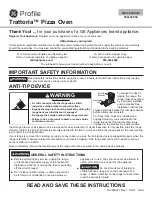
14
CLEANING AND MAINTENANCE
Any piece of equipment works better and lasts longer when maintained properly and kept clean.
C
Co
on
nd
de
en
nsse
err
The condenser tubing inside the cabinet does not require frequent cleaning; however, satisfactory cooling depends on
adequate ventilation over the coils. Be sure that nothing obstructs the required air flow openings in front of the
cabinet. Spiders and insects can nest in and around the wine cellar causing damage to the unit. Frequently brush or
vacuum lint and dirt from the condenser coils for efficient performance by unscrewing the grill on the bottom front of
cabinet.
C
Caab
biin
ne
ett
The cabinet can be washed with mild soap and water and thoroughly rinsed with clear water. Never use abrasive
scouring powders.
IIn
ntte
erriio
orr
Wash interior compartment with mild soap and water. Do not use abrasive powder, solvent, polish cleaner or undiluted
detergent.
S
Sttaaiin
nlle
essss S
Stte
ee
ell P
Paarrttss
All stainless steel parts should be wiped regularly with hot soapy water. Use a liquid cleaner designed for stainless
steel when soapy water will not do the job. D
Do
o n
no
ott u
usse
e steel wool, abrasive cloths, cleansers, or powders. Do not
permit citrus or tomato juice to remain on stainless steel surfaces, as citric acid will permanently discolor stainless steel.
B
Brraassss P
Paarrttss
C
CA
AU
UT
TIIO
ON
N:: All brass parts are coated with an epoxy coating. D
DO
O N
NO
OT
T U
US
SE
E B
BR
RA
AS
SS
S O
OR
R A
AB
BR
RA
AS
SIIV
VE
E C
CLLE
EA
AN
NE
ER
RS
S O
ON
N
T
TH
HE
E B
BR
RA
AS
SS
S P
PA
AR
RT
TS
S.. All brass parts should be wiped regularly with hot soapy water. When hot soapy water will not do
the job, use every day non-abrasive household cleaners.
G
Gllaassss D
Do
oo
orr
Use a glass cleaner or mild soap and water with a soft cloth to clean the glass door. Do not use any abrasive powders.
On full overlay models, use caution when cleaning near logo area.
P
Paaiin
ntte
ed
d S
Su
urrffaacce
ess
Wash with warm soapy water. D
DO
O N
NO
OT
T U
US
SE
E steel wool, abrasive cleansers, ammonia, acids or commercial oven
cleaners which may damage the finish.
D
Do
oo
orr G
Gaasskke
ett
The vinyl gasket may be cleaned with mild soap and water, a baking soda and water solution, or a mild scouring
powder.
LOADING RECOMMENDATIONS
Each of the top six roll-out racks holds 8 bottles with necks alternating front to back. The bottom wood cradle holds six
bottles for a total of 54 bottles. To aid in the loading and unloading, the racks extend up to 14 inches (35.6 cm) to
allow easier access to rear bottles. Tall bottles should not be loaded on the bottom rack because they may prevent the
door from closing. The bottom rack may be removed for storing “jug” wines. You may store magnum and other large
bottles on the upper right and left positions of the cabinet shelving or on any of the middle racks by removing the rack
directly above them. To remove a rack, first unlock the rack by pushing the lock backward. The lock is located on the
bottom front of each rack. After reinserting the rack, push the lock forward to lock the rack back into place. Position
white wines on the middle or lower racks and red wines on the upper racks. The bottles on the top rack directly under
the light will be exposed to a slightly higher temperature when the light is on. REMEMBER TO TURN OFF THE LIGHT
WHEN IT IS NO LONGER NEEDED. Keep wines that you plan to use for everyday drinking and entertaining on the
front half of the racks where labels are completely visible. Place wines for aging or longer term storage in the rear. Pull
wine racks out gently to minimize the unsettling of your wine collection. Avoid pulling out more than one rack at any
time to maintain stability.
Since the bottles are not
stacked on top of each other,
the single bottle roll-out rack
allows easy view and access
to your inventory without
disturbing other bottles
Front Bottles
(Necks Facing Rear)
Rear Bottles
(Necks Facing Front)


































